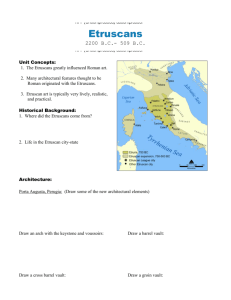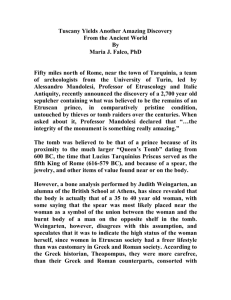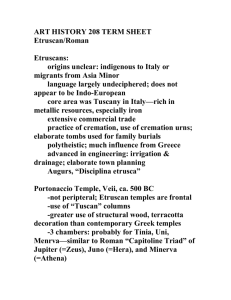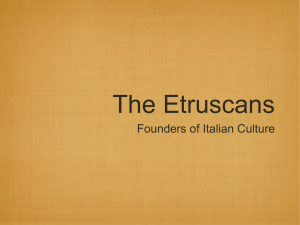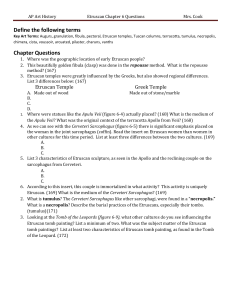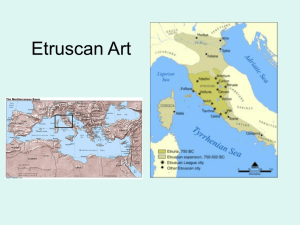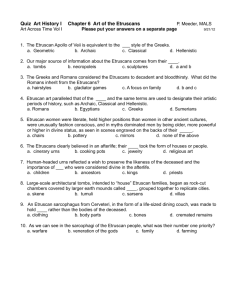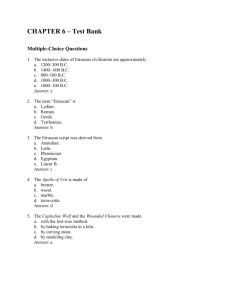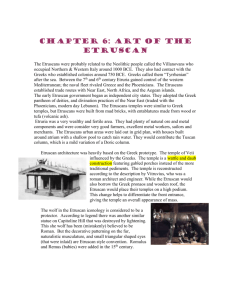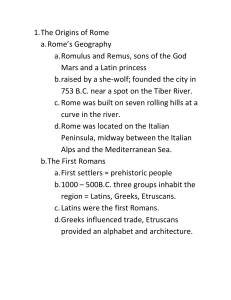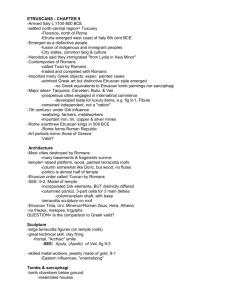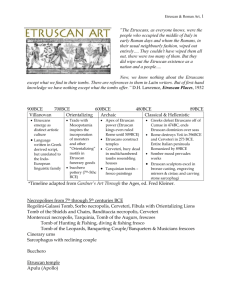Chapter%209%20
advertisement
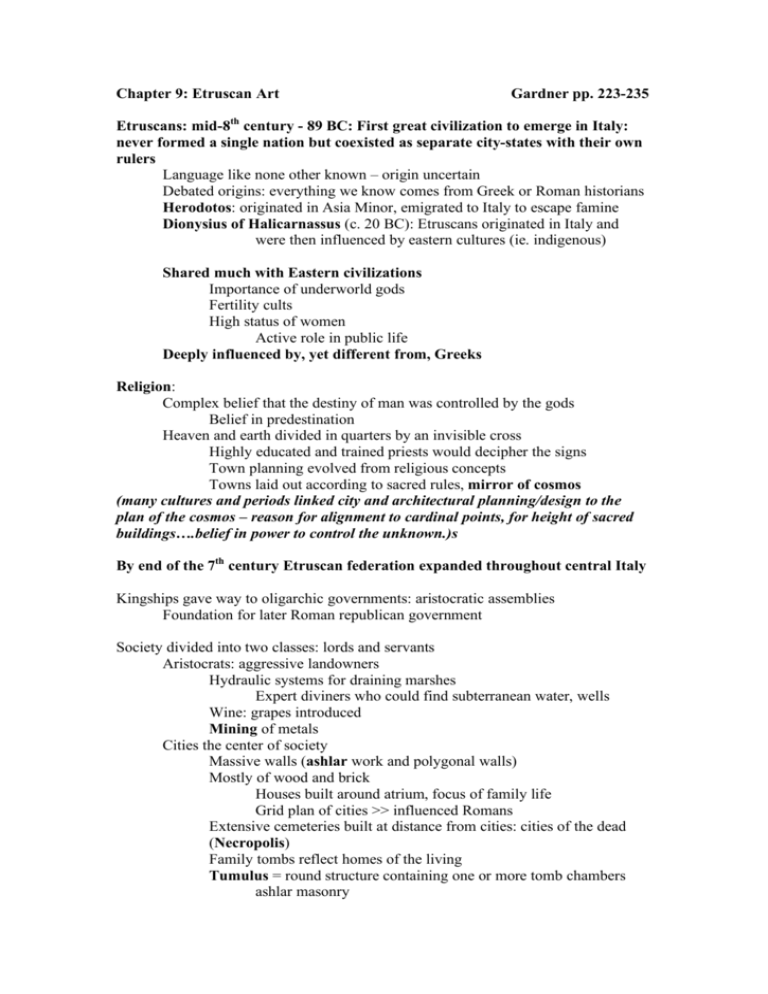
Chapter 9: Etruscan Art Gardner pp. 223-235 Etruscans: mid-8th century - 89 BC: First great civilization to emerge in Italy: never formed a single nation but coexisted as separate city-states with their own rulers Language like none other known – origin uncertain Debated origins: everything we know comes from Greek or Roman historians Herodotos: originated in Asia Minor, emigrated to Italy to escape famine Dionysius of Halicarnassus (c. 20 BC): Etruscans originated in Italy and were then influenced by eastern cultures (ie. indigenous) Shared much with Eastern civilizations Importance of underworld gods Fertility cults High status of women Active role in public life Deeply influenced by, yet different from, Greeks Religion: Complex belief that the destiny of man was controlled by the gods Belief in predestination Heaven and earth divided in quarters by an invisible cross Highly educated and trained priests would decipher the signs Town planning evolved from religious concepts Towns laid out according to sacred rules, mirror of cosmos (many cultures and periods linked city and architectural planning/design to the plan of the cosmos – reason for alignment to cardinal points, for height of sacred buildings….belief in power to control the unknown.)s By end of the 7th century Etruscan federation expanded throughout central Italy Kingships gave way to oligarchic governments: aristocratic assemblies Foundation for later Roman republican government Society divided into two classes: lords and servants Aristocrats: aggressive landowners Hydraulic systems for draining marshes Expert diviners who could find subterranean water, wells Wine: grapes introduced Mining of metals Cities the center of society Massive walls (ashlar work and polygonal walls) Mostly of wood and brick Houses built around atrium, focus of family life Grid plan of cities >> influenced Romans Extensive cemeteries built at distance from cities: cities of the dead (Necropolis) Family tombs reflect homes of the living Tumulus = round structure containing one or more tomb chambers ashlar masonry Temple: resembles Greek prostyle but rests on high base (podium) steps at one end only – focus on entrance/ axial organization wide pronaus (porch in front of cella) interior space to house cult god: cella divided into 3 wide space between columns, architrave of wood Maritime power: controlled Mediterranean sea trade Middle of 6th century: peak of military and commercial strength Power spread too thin – in conflict with Greeks and Rome which began to acquire commercial, political and military expertise 5th century: Rome gained independence and began to attack Etruscans: one by one the Etruscan cities fell to the Romans. Romans owed much to Etruscans Drainage of marshes of Rome, creation and paving of forum Stone work for building walls Temple design Fibula with orientalizing lions, from the Regolini-Galassi Tomb, Cerveteri, c. 650-640 BC, Vatican Golden clasp to fasten gown at shoulder Near eastern decorative motifs: 5 lions, cut out and applied to the ground 6th century BC Etruscan Temple Vitruvius: detailed description of Etruscan temple design Wood and sun-dried brick with terracotta decoration High podium Entrance staircase at front Columned façade porch Cella divided into 3 compartments for different cult figures Axial (unlike Greek which were meant to be seen from all angles) Highly decorated Function = ornate home for the cult image Human headed cinerary urn, 7th century, terracotta, Chiusi Pottery urns took on human shape with head growing out of lid Apollo, from roof of the Portonaccio Temple, Veii, c. 510-500 BC, Villa Giulia Life-size, molded terracotta Influence of Greek kore but without elegance Brightly painted Rippling folds Animated and yet heavy, lumbering gait Heroic idealization of the Greeks has been brought down to earth More descriptive, more factual Some organic form but mostly curvilinear stylizations/patterns Sarcophagus with reclining couple, from Cerveteri, c. 520 BC, painted terracotta, Villa Giula, Rome Form of rectangular dining couch Influence of archaic Greece No sense of skeletal structure Focus on upper parts of the body Animation of figures at banquet >> gesture Aristotle comments on strange fact that Etruscan men ate with their wives Freedom of Etruscan women >> could own property Importance of family unit Sarcophagus of Ramtha Visnai, from Vulci, c. 300-280 BC, limestone, MFA Married couple in bed >> ancient association of sleep with death Loving relationship Nudity signifies their continuing sexual union even in death Etruscan cemeteries: most of what we know about the Etruscans comes from their necropolis Cities of the dead Subterranean multi-chambered tombs cut out of local tufa Tumuli: not unlike the Mycenaean Treasury of Atreus Resembled domestic houses Tomb of the Reliefs, Cerveteri, 3rd century BC Meant to accommodate several generations of a single family Stucco reliefs, brightly painted Mourners at the Door of the Other World, Tomb of the Augurs, Tarquinia, c. 510 BC Representation of mourners facing door leading to next life On right, wrestlers competing for gold and bronze bowls Figures stand on horizontal ground Little indication of spatial depth Tomb of the Leopards, banqueting scene, detail of mural paintings, Tarquinia, c. 480-470 BC Exaggerated gestures (like Italians today) Joyful, celebratory Stylistically like archaic Greek vase painting Landscape elements Tomb of Hunting and Fishing, mural painting of diving and fishing, c. 530-20 BC Etruscan interest in representing nature Reminiscent of Tomb of Ti and Tomb of Nebamun Possible knowledge of Egyptian funerary traditions Think about rise of landscape: Egyptian: Tombs of Ti and Nebamun Minoan: Akrotiri frescoes Paestum: Tomb of Diver Etruscan: Tomb of Hunting and Fishing Rome: Boscotrecase, Agrippa’s villa, c. 11 AD China: Fan Kuan, Travelers among Mountains and Streams, N. Song, 11c Italy: Ambrogio Lorenzetti, Good Government, Palazzo Pubblico, 1338 Capitoline Wolf, c. 500-480 BC, bronze, Palazzo dei Conservatori, Rome Legend of Romulus and Remus Made for the Roman Republic after the expulsion of Tarquinius Superbus Emblem of the city of Rome Expressive animation combined with a sense of realism Warrior (Mars of Todi), bronze, early 4th century BC, Vatican Buried in a sarcophagus in ruins of Temple of Todi Etruscan interpretation of Polykleitos canon contrapposto Animated pose Cuirass over gathered skirt Aule Metele (Arringatore, orator), from Sanguineto, near Lake Trasimeno, early 1st century BC, bronze, Florence (name inscribed on hem) Discovered in 1566 Short toga and high laced boots of Roman magistrate (already a Roman citizen) Portrait Self-confidence Arm raised in gesture of address VOCABULARY: Podium Axial Ashlar masonry Necropolis tumulus
